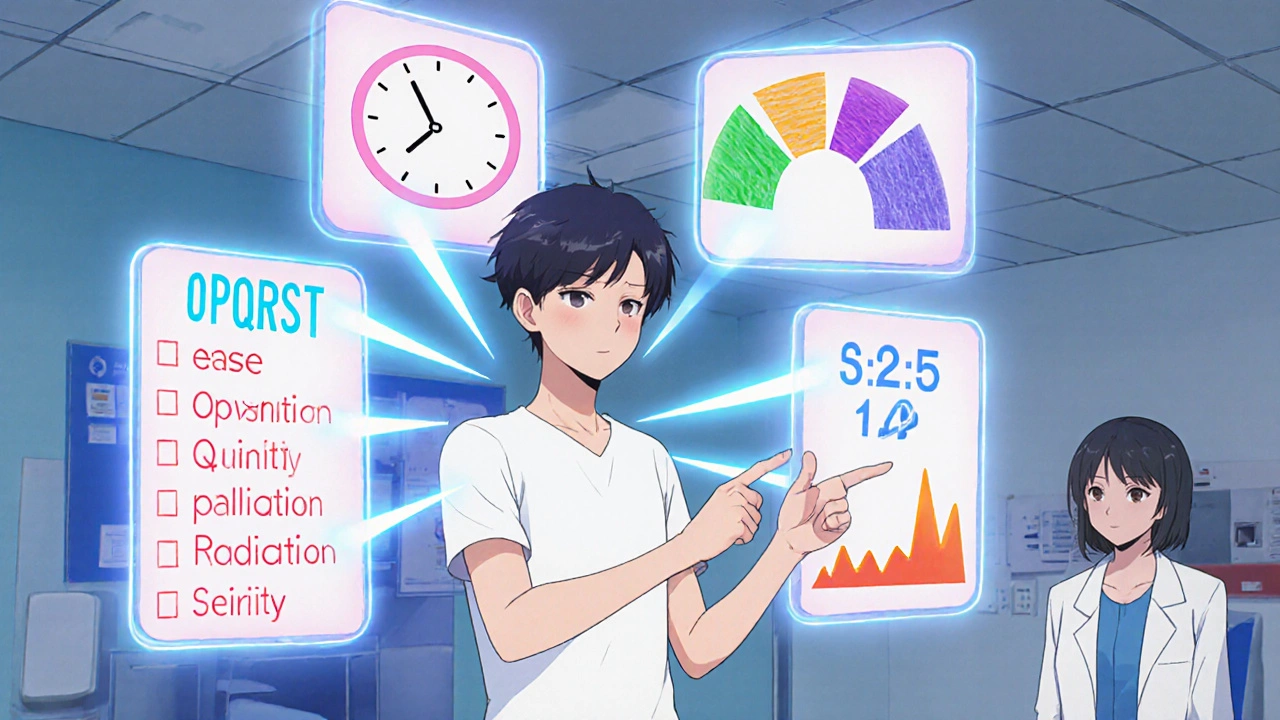Chest Pain Description Assistant
Your Chest Pain Description Assistant
Use this tool to practice describing chest pain using the OPQRST framework. Enter your symptoms below to get feedback on completeness.
When you feel that uncomfortable pressure in the middle of your chest, every second feels like a ticking clock. Chest Pain is a symptom that can signal anything from a harmless muscle strain to a life‑threatening heart attack. Getting the description right can mean the difference between a quick, accurate diagnosis and weeks of unnecessary tests. Below is a practical, no‑jargon playbook that helps you turn a vague feeling into clear, actionable information for any Healthcare Professional you meet.
Why Accuracy Saves Time (and Lives)
Doctors rely on a patient’s narrative to narrow down dozens of possible causes. A vague "I have chest pain" gives them a huge list to sort through. A precise description lets them prioritize high‑risk conditions-like Heart Attack-and order the right tests fast. Studies from the American Heart Association show that early, detailed symptom reporting cuts door‑to‑balloon time for heart attacks by up to 30 %.
Use the OPQRST Checklist
OPQRST is a simple mnemonic that turns an open‑ended story into a structured report. Answer each prompt in plain language, and you’ll have a ready‑to‑share script.
- Onset: When did the pain start? Was it sudden or gradual?
- Provocation/Palliation: What makes it worse or better? (e.g., walking, deep breath, sitting)
- Quality: How would you describe the sensation? Sharp, dull, burning, pressure, squeezing?
- Radiation: Does the pain move anywhere-up the arms, into the jaw, or the back?
- Severity: Rate it 0‑10. Does it feel like 2/10 at rest but spikes to 8/10 with activity?
- Timing: Is it constant, intermittent, or does it come in waves? How long does each episode last?
Practicing this checklist at home lets you recall the details under stress, so you won’t forget anything when you finally sit down with the doctor.
Key Elements to Mention
- Location: Pinpoint the spot-center of the chest, left side, right side, or behind the breastbone.
- Associated Symptoms: Shortness of breath, sweating, nausea, light‑headedness, or a feeling of impending doom. Even a mild headache can be relevant.
- Triggers: Physical exertion, emotional stress, meals, lying flat, or a recent cold.
- Alleviating Factors: Rest, sitting up, nitroglycerin, antacids, or deep breathing.
- Medical History: Prior heart disease, hypertension, diabetes, GERD, anxiety disorders, or recent surgeries.
Cardiac vs. Non‑Cardiac Pain: A Quick Primer
Understanding the hallmarks of common causes helps you frame your story. Below is a side‑by‑side look at the most frequent culprits.
| Cause | Typical Quality | Radiation | Key Triggers | Red‑Flag Symptoms |
|---|---|---|---|---|
| Heart Attack | Pressing, heavy, crushing | Left arm, jaw, back | Exertion, emotional stress | Profuse sweating, nausea, faintness |
| Angina | Squeezing, tightness | Often left arm or shoulder | Physical activity, cold weather | Relief with rest or nitroglycerin |
| Gastroesophageal Reflux Disease | Burning, acid‑like | Often up the throat | Heavy meals, lying flat | Improvement with antacids |
| Pulmonary Embolism | Sharp, stabbing | Often pleuritic, worsens with breathing | Recent surgery, prolonged immobility | Sudden shortness of breath, rapid heart rate |
| Anxiety Panic Attack | Sharp or pressure‑like | Often radiates to neck | Stressful thoughts, caffeine | Hyperventilation, feeling of unreality |
Notice how the "Quality" and "Radiation" columns line up with the OPQRST prompts. When you feed the doctor this structured data, they can quickly rule in or out the dangerous possibilities.
Sample Dialogue: Turning Your Story into a Report
Imagine you’re in the exam room. Here’s a concise way to convey everything:
“I started feeling a pressure in the center of my chest about two hours ago while climbing stairs. It’s a 7/10 right now and gets worse when I try to take a deep breath. The pain radiates to my left arm and jaw. I’m also sweating a lot and feel a bit nauseous. Resting for a few minutes drops it to a 4/10, but it comes back when I stand up.”
Notice how the narrative hits every OPQRST element without sounding rehearsed. Practicing a version like this at home helps you stay calm and clear.

Checklist: What to Have Ready Before You Arrive
- Write down the OPQRST answers on a piece of paper or phone note.
- List any medications you’re taking (especially nitroglycerin, antacids, or anxiety meds).
- Bring a brief medical history: past heart issues, surgeries, and known allergies.
- Know your family history of heart disease, high blood pressure, or clotting disorders.
- If you have an Electrocardiogram (ECG) report from a recent visit, pack it.
When to Call 911
If any of the following appear, treat it as an emergency and dial 911 immediately:
- Sudden, crushing chest pressure that doesn’t ease with rest.
- Chest pain accompanied by fainting, severe shortness of breath, or a rapid, irregular heartbeat.
- New pain that spreads to the jaw, back, or both arms.
- Severe sweating, nausea, or a sense of impending doom.
Even if you’re unsure, it’s safer to get evaluated in an emergency department.
Quick Recap: Your chest pain description Cheat Sheet
- Use OPQRST for a structured story.
- Specify location, quality, radiation, severity, timing, and triggers.
- Note associated symptoms like shortness of breath or sweating.
- Bring medication list, family history, and any recent ECG results.
- Call 911 if pain is crushing, spreads quickly, or comes with fainting.
What does a “pressure” feeling in the chest usually mean?
A pressure‑type pain often points to a cardiac cause such as a heart attack or angina, especially if it radiates to the left arm or jaw and is linked with sweating or nausea. However, pressure can also appear with severe acid reflux or a panic attack, so context matters.

How long should I wait before seeking emergency care?
If the pain is new, worsening, or accompanied by any red‑flag symptom (e.g., shortness of breath, fainting, radiating pain), call emergency services immediately. For milder, stable pain that improves with rest, schedule a same‑day appointment with your primary care provider.
Can I rely on over‑the‑counter antacids if I think my pain is heartburn?
Antacids can relieve true heartburn, but they won’t affect cardiac pain. If antacids don’t change the sensation within 15‑20 minutes, treat the episode as potentially cardiac and seek medical advice.
What role does an ECG play in diagnosing chest pain?
An Electrocardiogram (ECG) records the heart’s electrical activity. It can reveal heart attacks, arrhythmias, or signs of strain within minutes, making it a first‑line tool in emergency rooms and urgent care settings.
How does anxiety cause chest pain, and how can I tell it apart?
Anxiety triggers muscle tension and hyperventilation, producing sharp or pressure‑like pain that often improves with slow breathing or relaxation. Unlike cardiac pain, it rarely radiates to the left arm and is usually accompanied by feelings of dread, racing thoughts, or trembling.
Should I bring a family member to the appointment?
Having someone else listen can ensure no detail is missed, especially if you’re in pain. They can also help remember the doctor’s questions and next‑step instructions.

